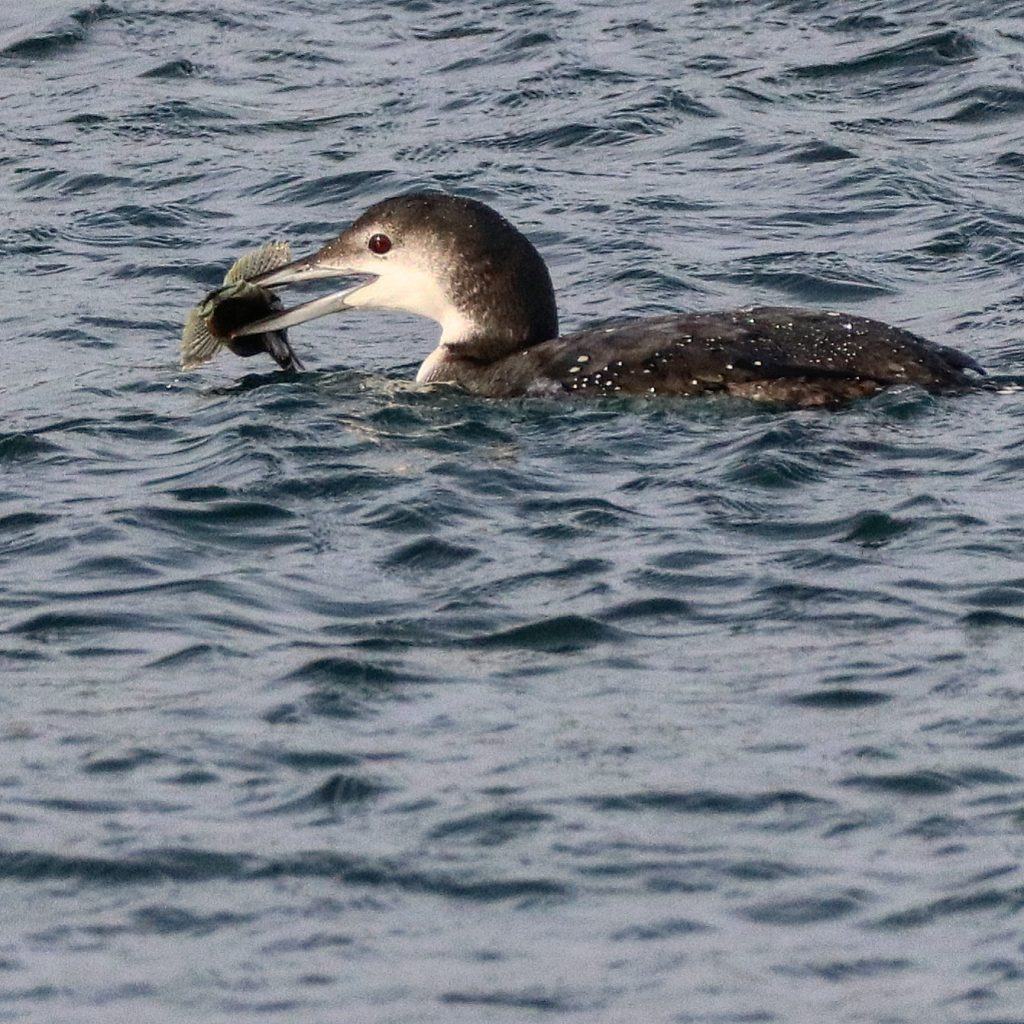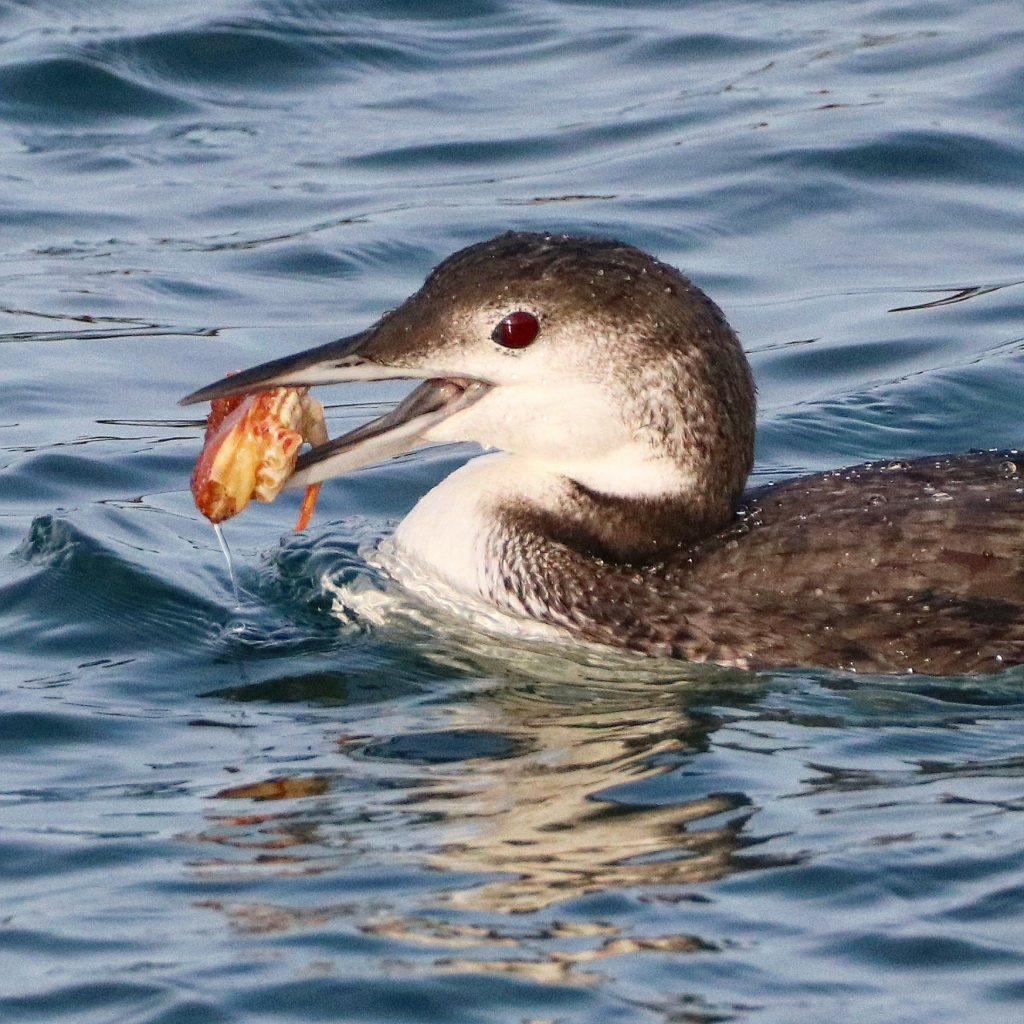Photo by Stewart Ting Chong
By Tamsin Venn
Winter paddling off the shores of Cape Ann can be a solitary affair, so it’s always cheering to share it with the Common Loon (Gavia immer). Loons stay fairly close to shore, so no need to venture far out in your kayak to see them. Like a kayaker, in winter, it tends toward the single individual or small groups.
Most of us are more familiar with the summer loon we see on inland lakes. In winter, instead of heading south, adult, young, and hatch-year birds migrate from open water on balmy inland lakes and ponds to the cold ocean. That is because their freshwater lakes and ponds freeze forcing them elsewhere.
As Mass Audubon trip leader David Moon said in a birding report from Plum Island, Mass., “The falling tide had exposed a bit of Emerson Rocks, and eiders, grebes, scoters, and a couple of loons all performed their remarkable ability to live happily on frigid waters.”
The Common Loon accomplishes the switch from fresh to salt water by the use of a supraorbital gland in its skull between the eyes that removes salt through excretion from ducts in its beak.
In appearance, it molts from its handsome black and white plumage with black head and bill into non-breeding plumage of gray back and head and white throat. The adult looks similar to the juvenile, the difference being the juvenile’s scalloping pattern on the back caused by whitish feather edgings. You will need binoculars for that ID, and close-up you might also spot the bright red eyes (from a pigment in the retina that filters light and allows the bird to see underwater).
As in summer, the male and female look very similar, but the female is slightly smaller. Loons are more silent in winter, and you will not necessarily hear the familiar maniacal laugh or haunting cry associated with their freshwater breeding grounds.
It’s hard to alert your paddling companion to a loon’s presence. It quickly dives, stays underwater for about 40 seconds, and turns up a fair distance from where it dove. Use of a clock face ID helps if you are both pointing in the same general direction. Loon at 3 o’clock!
What are loons doing under there? They are diving sometimes to a depth of 250 feet, to catch fish, crustaceans, and mollusks they often swallow underwater. Like other diving birds, the loons propel themselves underwater with large webbed feet placed well to the rear of their body. Unlike most birds, they have solid bones that make them less buoyant and aid in diving. They can also exhale quickly, emptying their lungs, and flatten their feathers to expel air from their plumage, making them fast and maneuverable. They go after fish whose speed and zig-zagging they can match.
Loons migrate from lakes and ponds in the New England area up to November, though most migrate in October. In Massachusetts, loons returned in 1975 after nearly 100 years of absence, according to the Mass Division of Fisheries and Wildlife. In summer, they nest in great numbers on Quabbin and Wachusett Reservoirs and other lakes in central and western parts of the state.
On inland lakes, some of the parents stay later to help their chicks, especially those born later in the summer. But they leave and let the young find their own way to the ocean a few weeks later, biologists are not sure how. The young will eventually return to their home lakes after swimming about in the ocean for two or three years.
Loons have to migrate. Their bodies are very heavy compared to their wing capacity. They have the second highest wing load of flying birds, after swans. On a windless day, to get enough air under their wings, they can run on water for up to a quarter-mile to get airborne, according to Harry Vogel, Senior Biologist for New Hampshire’s Loon Preservation Committee (LPC). Often on small lakes, people observe loons making one or two circuits around the lake. This is not a scenic tour. Every circuit helps them gain a few feet of altitude. Once up, they fly directly and swiftly, beating wings up to four times a second, and can maintain a speed of 80 mph at level flight. They can’t run on a lake that has frozen for take-off, causing them to become trapped and unable to survive unless they fly to open water, or are rescued, according to Vogel.
Squam Lake in New Hampshire has a robust loon protection program with many stewards. Through banding and satellite tracking, the LPC monitors more than 350 of the state’s lakes and ponds. LPC discovered that the New Hampshire loons winter off the coast of the Atlantic Ocean from Maine to Rhode Island. LPC’s staff and volunteers have been monitoring New Hampshire’s loons for more than 40 years.
Biologists think that loons return to the same general area where they were born, often returning to the same lake. Loons typically arrive in New Hampshire lakes and ponds just after ice-out, sometimes, uncannily, the very next day. There they breed and produce generally two chicks. Loons mate for life.
On lakes and ponds, they face a host of perils: lead poisoning from fishing tackle; mercury poisoning from coal fire powered plants and municipal incinerators (loons in the northeast have the highest levels of mercury in the U.S. as measured by eggshells and blood samples); shoreline development in popular summer retreats. Add to those dangers, predation from critters whose populations have exploded from access to human waste like raccoons, gulls, crows; boat wakes that swamp nests (loons have to nest on water’s edge because they can’t walk well on land with feet placed well to the rear of their bodies); boats that scare a loon off its nest subjecting the eggs to heat or cold; and raising and lowering of lake levels, either by natural or human forces, according to LPC. Fortunately loons have some seriously dedicated stewards.
Winter paddlers can also be on the lookout for the less common Red-throated loon, distinguished from the Common Loon by a whiter neck and face, a slightly upturned bill, and smaller body and weight. The Pacific Loon is a smaller bird with a smaller bill and a chin line, best ID’ed by the head. It is a rare winter visitor in the eastern U.S. and is the most commonly misidentified bird in Massachusetts, according to local ornithologist Dave Larson.
In early April offshore, some adult loons have already developed their black and white breeding plumage from their grey and white winter colors. Any day now, ice out arrives and we will have to travel to inland lakes to see these winter friends.
Tips: A word about binoculars: A monocle is a good tool to use for a kayaker, so you can keep one hand on your paddle. Loop the strap around your PFD and keep it in the pocket when not in use. Bouncing around in waves, even wavelets, can make it hard to get a bird settled in the scope. Wind can also push you past the viewing point. Here a double kayak is useful where one paddler holds the kayak in place or swings it into position, while the other uses the binoculars. It also provides a more stable, less bouncy platform. Also, heavier binoculars will steady the view in a bobbing kayak, and a stretchable strap will help take the tension off the neck. Again loop and secure these around your pfd in event of capsize. Meanwhile, go ashore if there is a suitable landing spot for steady ground and better viewing.
Put In: A good protected spot to put in and park is at Pavilion Beach in Gloucester, off Stacy Boulevard, near the Greasy Pole. From here, you can paddle around Gloucester Harbor, including the Jodrey State Fish Pier, a reliable winter birding spot for observing ocean birds, ducks, and gulls. You can also put in at the Gloucester Town Ramp, near the Blynman Canal Bridge, behind Gloucester High School. It has no launch fee for kayakers if you use the small beach to the side of the ramp. That puts you into the Annisquam River, and follows Cape Ann’s western rocky shoreline north up past Lane’s Cove where you can hug the shore on the look-out for loons. In summer, the Double-breasted cormorants take over.
Tamsin Venn wrote this series of sea kayaking and birding articles as a final project for completion of Mass Audubon’s Birder’s Certificate Program.


